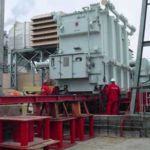 In May 2016, a bolt of lightning touched down on a golf course in Wichita Falls, Texas. It left a dramatic pattern of intricately branched singe marks that radiated from the center of the strike. Lighting bolts and the discharge of high-voltage services create this distinctive pattern. In electrical engineering and plasma physics, it is called a Lichtenberg figure.
In May 2016, a bolt of lightning touched down on a golf course in Wichita Falls, Texas. It left a dramatic pattern of intricately branched singe marks that radiated from the center of the strike. Lighting bolts and the discharge of high-voltage services create this distinctive pattern. In electrical engineering and plasma physics, it is called a Lichtenberg figure.
These fractals occur when a partial discharge of electricity invades an insulating material. Over time, exceptional electromagnetic fields stress dielectrics. Eventually, a partial discharge will progress through the weakened insulation. This phenomenon is known as electrical treeing due to the shape of the Lichtenberg figure, which resembles a network of tree branches. If the tree bridges the distance between two electrodes or conductors, it will cause complete failure.
Partial Discharge
Electrical treeing is a type of partial discharge that causes conductive ionization. When the electrical field is large enough, spontaneous ionization occurs, which makes the affected area highly conductive. This condition precedes a full-blown discharge. Certain partial discharges produce a visible halo of bluish light like a corona, but electrical treeing is invisible. That is why testing is so important.
Field Testing For Electrical Treeing
Partial discharge tests locate defects caused by manufacturing procedures, faulty splicing and normal operation. The test determines the location of partial discharges and the voltage that triggers treeing so that a replacement can be made before there is a catastrophic fault. Field testing is essential to prevent complete discharges and service interruptions at substations by predicting when major problems are likely to occur.
The goal of partial discharge testing is to assess the condition of the dielectric material. However, the process differs from conventional high-potential (hi-pot) protocols. Partial discharge tests are nondestructive, and the data is useful for quantitative analysis. During tests, the voltage is elevated to detect possible discharge sites. This allows field crews to determine the inception voltage for each partial discharge.
Baseline measurements on new power transformer equipment help high-voltage service providers to identify performance changes in the future. As equipment and insulation ages, field tests predict potential problems that could lead to catastrophic failure. Quality data allows testing specialists to analyze results and make performance-based decisions on maintenance, decommissioning and replacement.
Different Types of Electrical Treeing
Partial discharges can be identified during field tests and post-incident investigations. Experts can examine the insulation on cables, a power transformer and bushings to determine the primary cause of the discharge. Depending on conditions, the discharge will create different Lichtenberg figures that fall into one of the following categories.
- Bowtie
- Branch
- Bush
- Dendrite
- Spike
- String
- Vented
Bowtie and vented trees are the most common. They can be differentiated by the direction of the pattern and the point of initiation. Vented trees occur when there is a free air supply. They start at one electrode interface and grow toward the opposite electrode. Complete discharge and failure occurs when the tree links two electrodes.
Bowtie trees expand symmetrically away from the electrode. Failure is not as likely or as severe compared to discharges caused by vented trees. Bowtie trees do not have access to an air supply, so their growth is irregular. These trees do not usually grow long enough to cause complete failure by connecting two electrodes.
Causes of Electrical Treeing
Treeing occurs when a dielectric material is damaged or weakened. The root cause is often voids, gaps, air bubbles or impurities. Defects make the insulation vulnerable to partial discharges. Age is another cause of treeing in medium- and high-voltage cables, including cross-linked polyethylene (XLPE) products.
For additional information on partial discharge testing and substation maintenance, contact Equisales Associates by calling 713-733-3999. We are based in Houston and serve high-voltage clients and utilities around the world.

